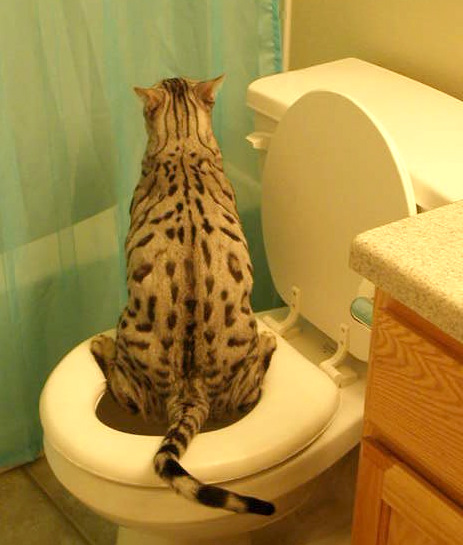Why You Mustn't Flush Cat Poop Down Your Toilet - Preserve Your Pipe Health
Why You Mustn't Flush Cat Poop Down Your Toilet - Preserve Your Pipe Health
Blog Article
Almost everyone may have their personal theory in relation to Don’t flush cat feces down the toilet.

Introduction
As feline owners, it's important to bear in mind just how we dispose of our feline buddies' waste. While it may seem convenient to flush cat poop down the toilet, this practice can have harmful repercussions for both the atmosphere and human health.
Environmental Impact
Purging pet cat poop introduces damaging virus and bloodsuckers right into the supply of water, positioning a significant risk to marine environments. These pollutants can adversely affect marine life and concession water high quality.
Wellness Risks
Along with environmental issues, flushing pet cat waste can also position health and wellness threats to human beings. Pet cat feces may include Toxoplasma gondii, a parasite that can cause toxoplasmosis-- a potentially severe disease, particularly for pregnant women and individuals with damaged body immune systems.
Alternatives to Flushing
The good news is, there are more secure and a lot more accountable ways to deal with cat poop. Take into consideration the complying with options:
1. Scoop and Dispose in Trash
The most usual technique of dealing with cat poop is to scoop it right into a biodegradable bag and toss it in the trash. Make certain to utilize a dedicated clutter scoop and take care of the waste quickly.
2. Usage Biodegradable Litter
Choose eco-friendly cat trash made from products such as corn or wheat. These litters are environmentally friendly and can be securely dealt with in the trash.
3. Hide in the Yard
If you have a lawn, consider burying feline waste in a designated area away from vegetable yards and water sources. Make certain to dig deep sufficient to avoid contamination of groundwater.
4. Set Up a Pet Waste Disposal System
Purchase a pet garbage disposal system specifically developed for pet cat waste. These systems use enzymes to break down the waste, minimizing odor and environmental influence.
Conclusion
Accountable family pet possession expands past providing food and shelter-- it likewise includes appropriate waste administration. By avoiding purging feline poop down the bathroom and selecting alternate disposal techniques, we can lessen our environmental footprint and protect human health.
Why Can’t I Flush Cat Poop?
It Spreads a Parasite
Cats are frequently infected with a parasite called toxoplasma gondii. The parasite causes an infection called toxoplasmosis. It is usually harmless to cats. The parasite only uses cat poop as a host for its eggs. Otherwise, the cat’s immune system usually keeps the infection at low enough levels to maintain its own health. But it does not stop the develop of eggs. These eggs are tiny and surprisingly tough. They may survive for a year before they begin to grow. But that’s the problem.
Our wastewater system is not designed to deal with toxoplasmosis eggs. Instead, most eggs will flush from your toilet into sewers and wastewater management plants. After the sewage is treated for many other harmful things in it, it is typically released into local rivers, lakes, or oceans. Here, the toxoplasmosis eggs can find new hosts, including starfish, crabs, otters, and many other wildlife. For many, this is a significant risk to their health. Toxoplasmosis can also end up infecting water sources that are important for agriculture, which means our deer, pigs, and sheep can get infected too.
Is There Risk to Humans?
There can be a risk to human life from flushing cat poop down the toilet. If you do so, the parasites from your cat’s poop can end up in shellfish, game animals, or livestock. If this meat is then served raw or undercooked, the people who eat it can get sick.
In fact, according to the CDC, 40 million people in the United States are infected with toxoplasma gondii. They get it from exposure to infected seafood, or from some kind of cat poop contamination, like drinking from a stream that is contaminated or touching anything that has come into contact with cat poop. That includes just cleaning a cat litter box.
Most people who get infected with these parasites will not develop any symptoms. However, for pregnant women or for those with compromised immune systems, the parasite can cause severe health problems.
How to Handle Cat Poop
The best way to handle cat poop is actually to clean the box more often. The eggs that the parasite sheds will not become active until one to five days after the cat poops. That means that if you clean daily, you’re much less likely to come into direct contact with infectious eggs.
That said, always dispose of cat poop in the garbage and not down the toilet. Wash your hands before and after you clean the litter box, and bring the bag of poop right outside to your garbage bins.
https://trenchlesssolutionsusa.com/why-cant-i-flush-cat-poop/

We had been made aware of that report about How to Dispose of Cat Poop and Litter Without Plastic Bags through a good friend on a different web property. Are you aware of another person who is curious about the topic? Take a moment to promote it. We take joy in reading our article about Can You Flush Cat Poo or Litter Down the Toilet?.
Browse Website Report this page